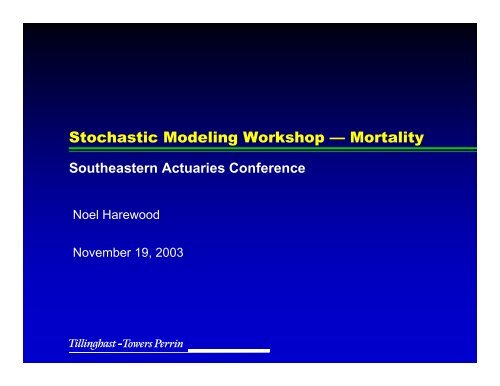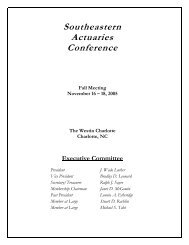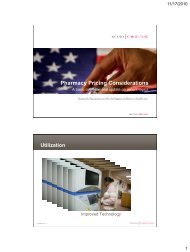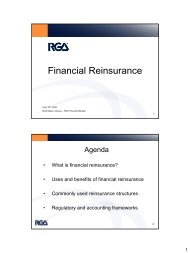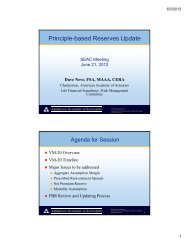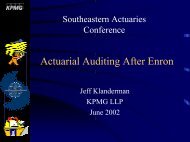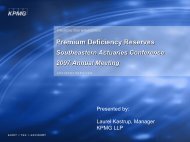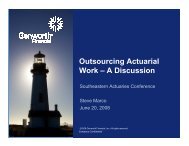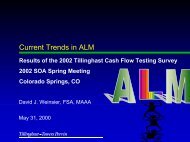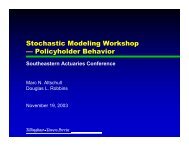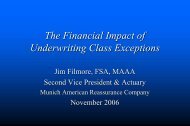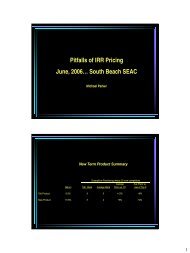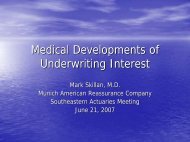Presentation by Noel Harewood - Actuary.com
Presentation by Noel Harewood - Actuary.com
Presentation by Noel Harewood - Actuary.com
You also want an ePaper? Increase the reach of your titles
YUMPU automatically turns print PDFs into web optimized ePapers that Google loves.
Stochastic Modeling Workshop — Mortality<br />
Southeastern Actuaries Conference<br />
<strong>Noel</strong> <strong>Harewood</strong><br />
November 19, 2003
Outline<br />
Overview<br />
Techniques for generating stochastic mortality<br />
scenarios<br />
Case studies: Practical applications of stochastic<br />
mortality<br />
Case Study 1: Senior settlements<br />
Case Study 2: COLI reinsurance<br />
Case Study 3: Economic capital<br />
Closing thoughts<br />
2
Overview
Stochastic mortality techniques can provide a heightened<br />
degree of insight to certain types of financial analyses<br />
Mortality assumptions have been traditionally modeled<br />
as a deterministic process, represented <strong>by</strong> a table of<br />
death rates. This approach is simple and allows for<br />
risks to be easily replicated and <strong>com</strong>pared.<br />
The deterministic approach, while often sufficient for<br />
most analyses, ignores two important aspects of<br />
mortality:<br />
Mortality volatility risk (mitigated due to the law of<br />
large numbers).<br />
Misestimation risk (controlled <strong>by</strong> underwriting).<br />
more . . .<br />
4
Stochastic mortality techniques can provide a heightened<br />
degree of insight to certain types of financial analyses (cont.)<br />
Additional considerations for these aspects be<strong>com</strong>es<br />
more necessary when:<br />
The analysis has a limited number of lives at risk.<br />
The economic consequences of death have a high<br />
severity but low probability of occurrence, such as<br />
the case of stop loss reinsurance.<br />
These situations can be best dealt with <strong>by</strong> employing<br />
stochastic mortality modeling techniques.<br />
When properly applied, stochastic mortality modeling techniques can<br />
provide useful insights into the variability in in financial performance of of a life<br />
insurance vehicle or or transaction.<br />
5
Techniques for Generating Stochastic<br />
Mortality Scenarios
Monte Carlo simulation is a <strong>com</strong>mon technique used to<br />
generate stochastic mortality scenarios<br />
<br />
<br />
<br />
Monte Carlo simulations associate a sequence of random<br />
numbers with a probability distribution to explain a real-life<br />
process, system or behavior.<br />
The key elements of a Monte Carlo simulation include:<br />
Random number generator<br />
Choice of a parameterized probability distribution<br />
Real-life interpretation of the random number generation<br />
A graphical representation of Monte Carlo simulation follows:<br />
Random Number<br />
Generator<br />
X i i<br />
= ε [0,1]<br />
PDF (Defined Process)<br />
Y i i<br />
~ Dist(parm1, parm2,…)<br />
X ii<br />
Solve for Y ii st<br />
X i i<br />
= F(Y i ; i parm1, parm2,…)<br />
more . . .<br />
7
Monte Carlo simulation is a <strong>com</strong>mon technique used to<br />
generate stochastic mortality scenarios (cont.)<br />
Example of Monte Carlo simulation of death rates on a<br />
cohort of N policies:<br />
N random numbers X i are generated on the unit<br />
interval.<br />
The parameterized probability distribution Y i ~<br />
Bernoulli(q x+ti ).<br />
Y i = 1 if X i > q x+ti (real-life interpretation: = insured<br />
survives), 0 if X i
Stochastic mortality rates can also be generated using<br />
two parameterization techniques<br />
Parameterization of Individual Mortality<br />
Assume a single paid-up whole life contract,<br />
where the present value of future benefit<br />
cash flows is a random variable:<br />
PVFBC = bv T<br />
T is the random variable for time until death,<br />
expressed as P(T
Case Studies<br />
Practical Applications of Stochastic Mortality
There are several practical applications of stochastic<br />
mortality being conducted in the industry today<br />
Senior settlements<br />
Stochastic mortality techniques are used to help<br />
evaluate heightened degree of mortality uncertainty<br />
surrounding senior settlements.<br />
COLI reinsurance<br />
Sellers of COLI sometimes purchase stop-loss<br />
reinsurance coverage to protect against catastrophic<br />
claims. Stochastic mortality techniques better<br />
exploit the risk profile of a treaty given the low<br />
frequency / high severity nature of the stop-loss<br />
transaction.<br />
more . . .<br />
11
There are several practical applications of stochastic<br />
mortality being conducted in the industry today (cont.)<br />
Economic capital analysis<br />
Actuaries evaluating economic capital on product<br />
lines whose financials are most heavily influenced<br />
<strong>by</strong> mortality experience may decide to run<br />
projections using stochastic mortality in addition to<br />
investment scenarios.<br />
Tillinghast developed case studies for each of the<br />
above examples. Results of these case studies are<br />
presented on the following slides.<br />
12
Case Study 1: Senior Settlements
A senior settlement is a transaction where ownership of a life<br />
insurance policy is sold for an amount greater than the cash<br />
value<br />
<br />
<br />
<br />
<br />
Senior settlements are bundled and sold as investments<br />
Typically, buyers do not have an insurable interest in the<br />
insured’s life<br />
Characteristics of typical senior settlement portfolios are as<br />
follows:<br />
Lives are aged 65 and older<br />
Each life is assessed a mortality rating (e.g., 200% of<br />
standard)<br />
− Life expectancy is <strong>com</strong>puted based on the base mortality<br />
table and the mortality rating<br />
Policies are for a relatively high face amount<br />
Limited number of policies involved in transaction (50 to 1,000)<br />
Reinsurance that pays out the death benefit two years after<br />
estimate of life expectancy is frequently utilized<br />
Given the limited number of lives and the reinsurance structure,<br />
senior settlement portfolios are prime candidates for stochastic<br />
mortality analysis<br />
14
We have analyzed a hypothetical senior<br />
settlement portfolio<br />
Lives ranged in age from 65 to 85<br />
Lives rated from standard to 600%<br />
<br />
50 lives in the portfolio<br />
Average Life Expectancy<br />
(Based on 1,000 Monte Carlo Simulations)<br />
Years<br />
11.0<br />
10.5<br />
10.0<br />
9.5<br />
9.0<br />
8.5<br />
8.0<br />
10.6<br />
10.3<br />
9.3<br />
9.4<br />
9.1<br />
Mean Median 75th Percentile 90th Percentile 95th Percentile<br />
Note: Life expectancy based on on base mortality of of 100% of of SOA 1990-95 experience<br />
table, age last birthday, select and ultimate. Extra mortality was kept level in in<br />
durations 5 and later. No mortality improvement was utilized<br />
15
As noted previously, reinsurance is available on senior<br />
settlement business where death benefit is paid out<br />
after the life expectancy plus two years<br />
Number of Lives Where Reinsurance is Paid<br />
(Based on 1,000 Monte Carlo Simulations)<br />
25<br />
20<br />
16.7 17<br />
19<br />
21<br />
22<br />
Lives<br />
15<br />
10<br />
5<br />
0<br />
Mean Median 75th<br />
Percentile<br />
90th<br />
Percentile<br />
95th<br />
Percentile<br />
Analysis demonstrates mortality volatility risk risk of of the the portfolio. However, results are are<br />
based on on assumed level level and and pattern of of mortality. Assumptions that that underly the the<br />
assumed level level and and pattern of of mortality include: base base mortality, mortality rating,<br />
implementation of of mortality rating, utilization of of mortality improvement. Misestimation<br />
of of any any of of these assumptions introduces a risk risk that that is is not not provided for for in in the the above<br />
stochastic analysis.<br />
16
Case Study 2: COLI Reinsurance
Case Study 2: COLI Reinsurance<br />
To protect against catastrophic claim experience,<br />
issuers of COLI sometimes enter into a stop-loss<br />
reinsurance agreement.<br />
Reinsurers will typically offer to cover a percentage of<br />
claims in excess of a defined threshold, in exchange<br />
for a retention charge (usually a % of AV or COIs).<br />
Reinsurers are faced with the following decisions when<br />
structuring the treaty:<br />
What percentage of claims in excess of the<br />
threshold satisfies profitability requirements?<br />
What risk profile are they willing to accept for a<br />
given treaty structure?<br />
more . . .<br />
18
Case Study 2: COLI Reinsurance (cont.)<br />
A case study was created to analyze stop-loss<br />
reinsurance transactions:<br />
The COLI treaty was first analyzed deterministically<br />
using best-estimate mortality assumptions.<br />
The treaty was then analyzed using stochastic<br />
mortality, as follows:<br />
− An MS-Excel spreadsheet was developed that<br />
projected cohort experience stochastically based<br />
on the Monte Carlo method.<br />
− For each scenario of cohort experience, fund<br />
values were generated and used to calculate the<br />
reinsurance net gain or loss on the transaction<br />
Results of the case study follow.<br />
19
Deterministic mortality projections do not provide the<br />
necessary depth to evaluate treaty characteristics<br />
<br />
<br />
<br />
The deterministic mortality assumption applied to certificateholders<br />
was 80% of the 83 GAM table.<br />
COLI product and reinsurance cash flows were projected assuming<br />
a 10, 20 and 30% quota-share percentage.<br />
Profitability and risk were analyzed <strong>by</strong> calculating the net present<br />
value of reinsurance cash flows, and the maximum probability of a<br />
reinsurance claim in a period:<br />
Key Metrics from Deterministic Projection<br />
Quota Share %<br />
80% 83 GAM 10% 20% 30%<br />
NPV Reinsurance<br />
Cash Flows ($ millions)<br />
$0.8<br />
$1.5<br />
$2.3<br />
Max P (Claim) in a Projection<br />
Period<br />
0.0%<br />
0.0%<br />
0.0%<br />
20
Deterministic mortality projections do not provide the<br />
necessary depth to evaluate treaty characteristics<br />
(cont.)<br />
The deterministic projection results suggest that higher<br />
quota-share percentages result in a more profitable<br />
out<strong>com</strong>e<br />
However, the best-estimate mortality assumptions<br />
never produce a large enough amount of<br />
certificateholder claims to force the reinsurer into a<br />
claim payment<br />
21
Stochastic mortality projections help the reinsurer<br />
better evaluate the risk profile of the stop-loss treaty<br />
<br />
Projecting the COLI cash flows over 1,000 stochastically<br />
generated Monte Carlo mortality scenarios produces the following<br />
range of returns for various quota-share percentages:<br />
NPV Reinsurance CFs <strong>by</strong> Quota Share %<br />
1000 Trial Projection, Expected Mortality = 80% 83 GAM<br />
NPV Reinsurance CFs<br />
2,000,000<br />
-<br />
(2,000,000)<br />
(4,000,000)<br />
(6,000,000)<br />
Best Est<br />
Min<br />
0.5%<br />
1.0%<br />
2.5%<br />
5.0%<br />
10.0%<br />
Percentile<br />
30% 20% 10%<br />
50.0%<br />
90.0%<br />
95.0%<br />
97.5%<br />
99.0%<br />
99.5%<br />
Max<br />
more . . .<br />
22
Stochastic mortality projections help the reinsurer<br />
better evaluate the risk profile of the stop-loss treaty<br />
(cont.)<br />
The best-estimate projection looks more like a best<br />
case scenario.<br />
The reinsurer can now not only evaluate whether the<br />
average returns are sufficient, but can also evaluate<br />
the treaty’s risk profile.<br />
23
Modifying the expected mortality assumption used to<br />
develop the Monte Carlo scenarios adds further insight<br />
(cont.)<br />
The reinsurer may also want to know the sensitivity of<br />
the projected reinsurance cash flows to changes in the<br />
underlying expected mortality assumption:<br />
NPV Reinsurance CFs <strong>by</strong> Expected Mortality %<br />
1000 Trial Projection, Quota Share % = 20%<br />
NPV Reinsurance CFs<br />
2,000,000<br />
-<br />
(2,000,000)<br />
(4,000,000)<br />
(6,000,000)<br />
Best Est<br />
Min<br />
Percentile<br />
0.5%<br />
1.0%<br />
2.5%<br />
5.0%<br />
10.0%<br />
50.0%<br />
90.0%<br />
95.0%<br />
97.5%<br />
99.0%<br />
99.5%<br />
Max<br />
70% 83GAM 80% 83GAM 90% 83GAM<br />
24
Modifying the expected mortality assumption used to<br />
develop the Monte Carlo scenarios adds further insight<br />
(cont.<br />
The profitability and risk profile of the treaty change<br />
dramatically when introducing a 10 percentage point<br />
change in expected mortality.<br />
This degree of mortality sensitivity goes undiscovered<br />
when analyzing only deterministic mortality projection<br />
results, as shown <strong>by</strong> the ‘Best Est’ results.<br />
25
Case Study 3: Economic Capital
Case Study 3: Economic Capital for SPIAs<br />
Single Premium Immediate Annuities (SPIAs) contain<br />
an element of mortality risk<br />
Payments made for the lifetime of the annuitant<br />
“True” value of $1 annuity is a T , where T is the<br />
future lifetime of the annuitant<br />
Profits decline if T > E(T)<br />
From a risk management and capital management<br />
perspective, how much capital should be set aside to<br />
cover mortality volatility risk?<br />
Current best practice indicates that this is a useful<br />
application of stochastic modeling<br />
27
Under a deterministic scenario, there is no mortality<br />
volatility risk<br />
Required assets (assets necessary to ensure<br />
solvency) are set equal to the gross premium reserve<br />
using best estimate assumptions<br />
Assumes constant investment rate<br />
Issue Age<br />
65<br />
75<br />
85<br />
Required Assets<br />
$87,083<br />
88,276<br />
89,213<br />
Mortality based on 100% of the 2000 SOA Basic Annuity Table<br />
Reserves based on $100,000 gross premium<br />
28
Projection of stochastic mortality produces a range of<br />
required asset values<br />
1,000 mortality scenarios projected<br />
Scenarios based on parameterization of aggregate<br />
death rates<br />
Model used is q 1 x+t = a t,i x q x+t<br />
− Where a t,I ~ Normal (1, (q x+t x p x+t )/n)<br />
− q x+t is the tabular death rate<br />
Mortality risk capital for a particular scenario is equal to<br />
the required assets less the best estimate gross<br />
premium reserve<br />
more . . .<br />
29
Projection of stochastic mortality produces a range of<br />
required asset values (cont.)<br />
<br />
Typically, required capital set to cover some specified level of risk<br />
− We have assumed MCTE(90)<br />
− Results expressed as bps of gross premium reserve<br />
Issue Age 10 Lives 100 Lives 1,000 Lives<br />
65<br />
7.7 bps<br />
3.8 bps<br />
1.6 bps<br />
75<br />
22.0<br />
8.2<br />
2.9<br />
85<br />
55.7<br />
18.9<br />
6.3<br />
<br />
Results confirm that risk increases with age and decreases with<br />
number of lives<br />
30
Effect of a Mortality Shock on Capital<br />
Stochastic modeling is also very useful in projecting<br />
mortality where there is a reasonable likelihood of a<br />
discontinuity<br />
E.g., a single significant shock to mortality<br />
We modeled the effect of a single shock to mortality<br />
A 25% permanent improvement in mortality at the<br />
end of the second year of the projection<br />
10% chance of shock occurring<br />
A practical example of this may be a sudden<br />
significant medical advance, e.g., a cure for cancer<br />
A possible deterministic approaches to calculating<br />
capital is to hold an amount assuming the shock<br />
occurs<br />
31
Effect of a Mortality Shock on Capital<br />
<br />
Stochastic modeling allows a more precise determination of<br />
capital<br />
Risk Capital<br />
Shock occurs<br />
Initial volatility<br />
Stochastic<br />
740 bps<br />
8<br />
741<br />
<br />
<br />
Introducing the possibility of a permanent shock significantly<br />
increases the mortality risk of the contract<br />
Note that stochastic modeling produces a result lower than the<br />
sum of the “worst case” method and the initial result<br />
32
Closing Thoughts<br />
Stochastic modeling of mortality can be a useful<br />
enhancement of life insurance modeling<br />
Particularly useful in certain cases<br />
− Low number of lives covered<br />
− Impact of mortality results on financial results is<br />
discontinuous<br />
Certain organizations may be significantly exposed to<br />
mortality risk<br />
Particularly reinsurers<br />
Further research in this area is needed<br />
33


